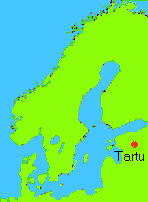Meet the Middle Ages
BackTartu

In 1030 the Grand Prince Jaroslav founded a town in central Estonia which he called Jurev. In 1224 the town was conquered by the military order the Teutonic Knights, which made it an Episcopal seat called Dorpat.
During the late Middle Ages the Hanseatic League took control of the town and Dorpat grew into an important commercial town where one traded in fur, timber and tar. The most important article of import was salt. During the 16th century, the town lost a great deal of its importance as a commercial centre.
In 1625 Dorpat became a part of the Swedish Empire. In 1632, a Swedish university was founded in the town and the Swedes tried to introduce Swedish law and administration in the Baltic territories. To make this possible, a court of appeal was established in Dorpat, the third one in the Swedish kingdom, in 1630.
During the great Nordic war the Russians conquered Dorpat in 1704. The town then remained under Russia until the end of World War I. In 1920 Dorpat became a town in Estonia. In 1940, Estonia was occupied by the Soviet Union. But since 1991 Tartu is once again a cultural centre in independent Estonia.